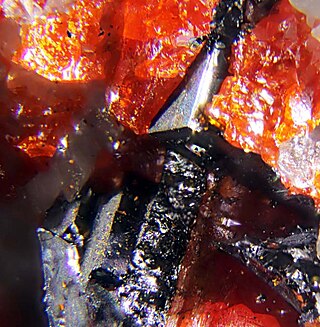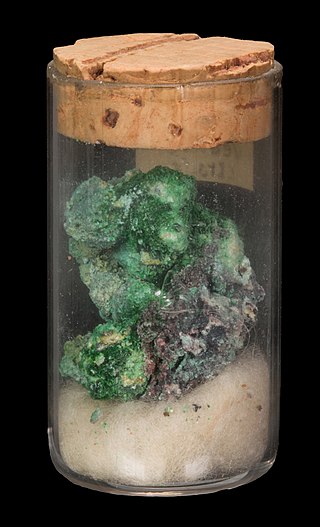Related Research Articles

Cotunnite is the natural mineral form of lead(II) chloride (PbCl2). Unlike the pure compound, which is white, cotunnite can be white, yellow, or green. The density of mineral samples spans range 5.3–5.8 g/cm3. The hardness on the Mohs scale is 1.5–2. The crystal structure is orthorhombic dipyramidal and the point group is 2/m 2/m 2/m. Each Pb has a coordination number of 9. Cotunnite occurs near volcanoes: Vesuvius, Italy; Tarapacá, Chile; and Tolbachik, Russia.

Piypite is a rare potassium, copper sulfate mineral with formula: K2Cu2O(SO4)2. It crystallizes in the tetragonal system and occurs as needlelike crystals and masses. Individual crystals are square in cross-section and often hollow. It is emerald green to black in color with a vitreous to greasy luster.
Feodosiyite is a very rare chloride mineral, just recently approved, with the formula Cu11Mg2Cl18(OH)8•16H2O. Its structure is unique. Feodosiyite comes from the Tolbachik volcano, famous for many rare fumarolic minerals. Chemically similar minerals, chlorides containing both copper and magnesium, include haydeeite, paratacamite-(Mg) and tondiite.
Heptasartorite is a very rare mineral with formula Tl7Pb22As55S108. It belongs to sartorite homologous series. It is related to other recently approved minerals of the series: enneasartorite and hendekasartorite. All three minerals come from a quarry in Lengenbach, Switzerland, which is famous of thallium minerals. Chemically similar minerals include edenharterite and hutchinsonite.

Hendekasartorite is a very rare thallium sulfosalt mineral with formula Tl2Pb48As82S172. It is one of recently approved new members of sartorite homologous series, by enneasartorite and heptasartorite. All new members come from Lengenbach quarry in Switzerland, prolific in terms of thallium sulfosalt minerals. Hendekasartorite is chemically similar to edenharterite and hutchinsonite.

Juansilvaite is a very rare, complex arsenate-sulfate mineral with formula Na5Al3[AsO3(OH)]4[AsO2(OH)2]2(SO4)2·4H2O. It is both hydroxyarsenate and dihydroxyarsenate. It is among few relatively new minerals from the Torrecillas mine in Chile, the other being torrecillasite, canutite, chongite, gajardoite, leverettite, and magnesiokoritnigite. Although having quite common among minerals space group C2/c, juansilvaite has a new type of structure.
Vasilseverginite is a very rare arsenate-sulfate mineral with formula Cu9O4(AsO4)2(SO4)2. Its structure is of a new type. It possesses a typical feature of many minerals of its type locality, the Tolbachik volcano, namely being a salt with oxide anions. However, it is the first Tolbachik copper oxysalt that is both arsenate and sulfate. Vasilseverginite is monoclinic, with space group P21/n.
Fermiite is a rare uranium mineral with the formula Na4(UO2)(SO4)3·3H2O. Chemically related minerals include oppenheimerite, meisserite (which is also structurally-related to fermiite), belakovskiite, natrozippeite and plášilite. Fermiite comes from the Blue Lizard mine, San Juan County, Utah, USA, which is known for many rare uranium minerals. The name honors Enrico Fermi (1901–1954).
Belakovskiite is a very rare uranium mineral with the formula Na7(UO2)(SO4)4(SO3OH)(H2O)3. It is interesting in being a natural uranyl salt with hydrosulfate anion, a feature shared with meisserite. Other chemically related minerals include fermiite, oppenheimerite, natrozippeite and plášilite. Most of these uranyl sulfate minerals was originally found in the Blue Lizard mine, San Juan County, Utah, US. The mineral is named after Russian mineralogist Dmitry Ilych Belakovskiy.
Meisserite is a very rare uranium mineral with the formula Na5(UO2)(SO4)3(SO3OH)(H2O). It is interesting in being a natural uranyl salt with hydrosulfate (hydroxysulfate) anion, a feature shared with belakovskiite. Other chemically related minerals include fermiite, oppenheimerite, natrozippeite and plášilite. Most of these uranyl sulfate minerals was originally found in the Blue Lizard mine, San Juan County, Utah, USA. The mineral is named after Swiss mineralogist Nicolas Meisser.
Oppenheimerite is a very rare uranium mineral with the formula Na2(UO2)(SO4)2•3H2O. Chemically related minerals include fermiite, natrozippeite, plášilite, belakovskiite and meisserite. Most of these uranyl sulfate minerals were originally found in the Blue Lizard mine, San Juan County, Utah, US. The mineral is named after American Theoretical physicist J. Robert Oppenheimer.
Chrysothallite is a rare thallium-bearing chloride mineral with the formula K6Cu6Tl3+Cl17(OH)4•H2O. Chrysothallite is unique in being only the second mineral with essential trivalent thallium, a feature shared with natural thallium(III) oxide, avicennite. Another examples of natural thallium chlorides are steropesite, Tl3BiCl6, and lafossaite, TlCl. Chrysothallite is one of numerous fumarolic minerals discovered among fumarolic sites of the Tolbachik volcano, Kamchatka, Russia The mineral is named in allusion to its colour and thallium content.
Itelmenite is a rare sulfate mineral with the formula MnCr2S4. It was discovered in Social Circle meteorite found in Georgia, US.
Hermannjahnite is a rare sulfate mineral with the relatively simple formula CuZn(SO4)2. It is one of many fumarolic minerals discovered on the Tolbachik volcano.
Manganiceladonite is a rare silicate mineral with the formula KMgMn3+Si4O10(OH)2. It is one of many minerals discovered in the Cerchiara mine, La Spezia, Liguria, Italy.
Kainotropite is a rare vanadate mineral with the formula Cu4FeO2(V2O7)(VO4). It contains trivalent iron. It is one of many fumarolic minerals discovered on the Tolbachik volcano. The name of its parental fumarole is "Yadovitaya", which means poisonous.

Shumwayite is a rare but relatively simple uranyl sulfate mineral with the formula (UO2)2(SO4)2•5H2O. It was discovered in the Green Lizard and Giveaway-Simplot mines of the White Canyon mining district, San Juan County, Utah, US.
Plavnoite is a rare complex uranium sulfate mineral with the formula K0.8Mn0.6[(UO2)2O2(SO4)]•3.5H2O. Typically for the secondary uranium mineral, plavnoite contains uranyl groups. It was discovered in the Plavno mine in Jáchymov, Czech Republic. The Jáchymov site is known as a type locality for many rare and unique minerals.
Wampenite is a rare organic mineral with the formula C18H16, found in Wampen, Fichtelgebirge, Bavaria, Germany.

Euchlorine (KNaCu3(SO4)3O) is a rare emerald-green sulfate mineral found naturally occurring as a sublimate in fumaroles around volcanic eruptions. It was first discovered in fumaroles of the 1868 eruption at Mount Vesuvius in Campania, Italy by Arcangelo Scacchi. The name 'euchlorine' comes from the Greek word εΰχλωρος meaning "pale green" in reference to the mineral's color, other reported spellings include euclorina, euchlorin, and euchlorite.
References
- ↑ Warr, L.N. (2021). "IMA–CNMNC approved mineral symbols". Mineralogical Magazine. 85 (3): 291–320. Bibcode:2021MinM...85..291W. doi: 10.1180/mgm.2021.43 . S2CID 235729616.
- 1 2 Nazarchuk, E.V., Siidra, O.I.,Agakhanov, A.A., Lukina, E.A., Avdontseva,E.Y., Vergasova, L.P., Filatov, S.K., and Karpov, G.A., 2015. Itelmenite, IMA 2015-047. CNMNC Newsletter No. 27, October 2015, 1225; Mineralogical Magazine 79, 1229–1236
- ↑ "Tolbachik volcano, Kamchatka Oblast', Far-Eastern Region, Russia - Mindat.org". Mindat.org. Retrieved 2016-03-13.
- ↑ "Saranchinaite: Saranchinaite mineral information and data". Mindat.org. Retrieved 2016-03-13.
- ↑ "Dravertite: Dravertite mineral information and data". Mindat.org. Retrieved 2016-03-13.